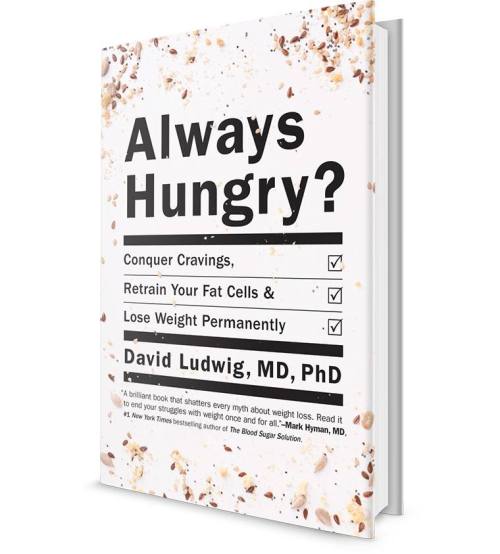Always Hungry: 7 key things to know about this revolutionary diet-ditching book
Here's what you need to know about Dr. Lustig's super popular diet book, "Always Hungry?" which creates a healthy eating program for long-term weight loss.

Every year, health writers drop hundreds of diet books, most of which offer some new spin on the “eat way less = you’ll probably drop pounds” equation—utterly ignoring the fact that you’ll also be a hangry mess.

Then along comes a book that not only generates serious buzz, but also has staying power. Right now that book is Always Hungry? by David Ludwig, MD, PhD—a super well-credentialed endocrinologist and researcher at Boston Children’s Hospital, as well as a professor of pediatrics at Harvard Medical School and professor of nutrition at Harvard School of Public Health (phew).
The gist? Starving yourself is a terrible idea, particularly at the cellular level. Instead, if you fuel the body with good, whole foods (carbs included!), you can actually reprogram your fat cells to help promote weight loss. And you won’t always feel so damn hungry.
During his 16-week pilot program, Dr. Ludwig tracked 237 participants who carefully followed the diet plan. Some lost weight within a week; others saw a more gradual drop, but nearly all of the participants reported reduced hunger and cravings, increased enjoyment of food, better energy, and an improvement in overall well-being, he says.
What do you need to know about the Always Hungry approach? Here’s a cheat sheet to help break it all down.
1. Most calorie-restricting diets are doomed to fail.
It’s crazy how hard it can be for this message to really sink in, which is why Dr. Ludwig spends a lot of time on it. Hardcore calorie restriction might lead to weight loss, but it’s just not sustainable. “Though we may be able to ignore those unpleasant feelings for a short while, they inevitably erode our motivation and willpower,” he says.
When the body goes into starvation mode, it starts to fight back, leading to food cravings and a way slower metabolism. So even if you manage to deprive yourself for a while, the body finds a way to adjust (as many contestants on The Bigger Loser have found).
2. Forget “calories in, calories out.”
“Conventional diets aim to shrink body fat by restricting calories. But this is doomed to fail, because it targets the symptoms, not the cause,” Dr. Ludwig writes. The real cause, he says, is eating too many high-glycemic foods (think refined sugars and carbs), which throw the body’s hormones and metabolism out of balance.
“Although a bottle of cola and a handful of nuts may have the same calories, they certainly don’t have the same effects on metabolism,” he writes.
 3. The key is using food to target fat tissue and retrain your body.
3. The key is using food to target fat tissue and retrain your body.
It’s not as simple as: too much food equals weight gain. In fact, obesity itself can make you overeat, Dr. Ludwig believes. If your fat cells are storing too many calories, your metabolism doesn’t really fire. To rectify that, the brain creates temporary hunger signals, which can then lead to overeating—and the cycle goes on and on.
Here’s what’s important: Eating the right foods (whole foods and healthy fats) can help lower insulin in the body, in turn reprogramming fat cells that were previously in calorie-storage mode.
4. You have to find your foods.
Since this is about reprogramming how your body works at a fundamental level, actually listening to your body is key. Observe how your body reacts to different foods. If you don’t like a particular lean protein, find one you do. If a food makes you feel sluggish or bloated, move on.
5. Eat when you start to feel hungry; stop when you’re satisfied, not full.
It’s mindfulness 101, but Dr. Ludwig says this very basic practice is essential.
6. Take it in stages.
Dr. Ludwig suggests a three-phase approach:
Phase 1: Conquer your cravings. For two weeks, you ditch grain products, potatoes, and added sugars to jump-start weight loss. Calories should come from 50 percent fat, 25 percent protein, and 25 percent carbohydrates. Fresh fruits, green vegetables, dairy products, and a bit of dark chocolate are all A-okay.
Phase 2: Retrain your fat cells. During this phase, moderate amounts of whole-kernel grains, starchy vegetables (except white potatoes), and a small amount of sweeteners are added back into your diet, which is 40 percent fat, 35 percent carbohydrate, and 25 percent protein. This phase can be as short as two weeks or as long as six months, depending on how much weight you want to lose.
Phase 3: Lose weight permanently. Here’s where you can reintroduce bread, potato products, and some processed carbs, with a ratio of 40 percent fats, 40 percent carbohydrates, and 20 percent proteins. The key to this phase is observing how your body handles adding these foods back in.
7. Sleep, sleep, sleep.
More than 30 percent of adults in this country get under six hours a night, Dr. Ludwig writes—about two hours shy of what’s generally recommended. But a lack of sleep not only leads to poor eating decisions, it affects your hormones, which screw with your metabolism, and not in a good way. Remember: hunger and exhaustion are not your friends!
For some hearty, whole-food dishes to get your healthy eating mojo back on track, check out these three wholesome recipes to calm cravings—or try these must-have macro bowl add-ons.
Sign Up for Our Daily Newsletter
Get all the latest in wellness, trends, food, fitness, beauty, and more delivered right to your inbox.
Got it, you've been added to our email list.










